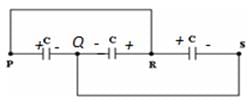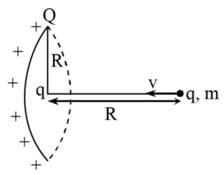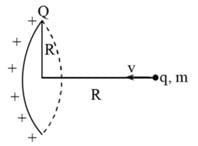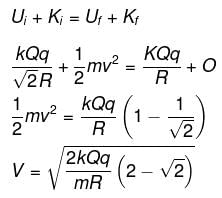All Exams >
EmSAT Achieve >
Physics for EmSAT Achieve >
All Questions
All questions of Electrostatic Potential for EmSAT Achieve Exam
Two equipotential surfaces have a potential of -10V and 90V respectively, what is the difference in potential between these surfaces?- a)90V
- b)80V
- c)0V
- d)100V
Correct answer is 'D'. Can you explain this answer?
Two equipotential surfaces have a potential of -10V and 90V respectively, what is the difference in potential between these surfaces?
a)
90V
b)
80V
c)
0V
d)
100V
|
|
Krishna Iyer answered |
Potential = high potential - low potential
so our high potential is 90V and low potential is 10V,
potential = 90-(-10)=100V
so our high potential is 90V and low potential is 10V,
potential = 90-(-10)=100V
Work done in carrying 2C charge in a circular path of radius 2m around a charge of 10C is- a)6.67J
- b)60J
- c)Zero
- d)15J
Correct answer is option 'C'. Can you explain this answer?
Work done in carrying 2C charge in a circular path of radius 2m around a charge of 10C is
a)
6.67J
b)
60J
c)
Zero
d)
15J
|
|
Suresh Iyer answered |
The overall work performed in carrying a 2coulomb charge in a circular orbit of radius 3 m around a charge of 10 coulomb is calculated below.
It is a well-known fact that W=qdv.
Here dV is the change in overall potential. In the circular orbit of r potential at each point is similar.
Most significantly, the value of r is 3.
The value of dv=0 and hence W=q0=0.
It is a well-known fact that W=qdv.
Here dV is the change in overall potential. In the circular orbit of r potential at each point is similar.
Most significantly, the value of r is 3.
The value of dv=0 and hence W=q0=0.
Electric field intensity at point ‘B’ due to a point charge ‘Q’ kept at a point ‘A’ is 12 NC-1 and the electric potential at a point ‘B’ due to same charge is 6 JC-1. The distance between AB is- a)2 m
- b)1.5 m
- c)1 m
- d)0.5 m
Correct answer is option 'D'. Can you explain this answer?
Electric field intensity at point ‘B’ due to a point charge ‘Q’ kept at a point ‘A’ is 12 NC-1 and the electric potential at a point ‘B’ due to same charge is 6 JC-1. The distance between AB is
a)
2 m
b)
1.5 m
c)
1 m
d)
0.5 m
|
|
Nandini Patel answered |
As we know , E . l = V where,
E = electric field intensity = 12 N/C
V = electric potential = 6 J/C
=> distance between A and B ,
l = ( 6 / 12 ) m or ( 1 / 2 ) m = 0.5 m
If 100 J of work has to be done in moving an electric charge of 4C from a place where potential is -5 V to another place, where potential is V volt. The value of V is- a)15 V
- b)20 V
- c)25 V
- d)10 V
Correct answer is option 'B'. Can you explain this answer?
If 100 J of work has to be done in moving an electric charge of 4C from a place where potential is -5 V to another place, where potential is V volt. The value of V is
a)
15 V
b)
20 V
c)
25 V
d)
10 V
|
|
Suresh Iyer answered |
From the definition, the work done to a test charge ‘q0’ from one place to another place in an electric field is given by the formula
W=q0x[vfinal-vinitial ]
100=4x[v-(-5)]
v+5=25
v=20V
W=q0x[vfinal-vinitial ]
100=4x[v-(-5)]
v+5=25
v=20V
Can you explain the answer of this question below:Equal charges are given to two spheres of different radii. The potential will
- A:
be equal on both the spheres
- B:
be more on the smaller sphere
- C:
be more on the bigger sphere
- D:
depend on the material of the sphere
The answer is b.
Equal charges are given to two spheres of different radii. The potential will
be equal on both the spheres
be more on the smaller sphere
be more on the bigger sphere
depend on the material of the sphere

|
Pranjal Pillai answered |
Explanation:
When equal charges are given to two spheres of different radii, the potential will be more on the smaller sphere. This can be explained using the formula for electric potential, which is given by:
V = k * Q / r
where V is the electric potential, k is the electrostatic constant, Q is the charge on the sphere, and r is the radius of the sphere.
Explanation:
1. Electric Potential is inversely proportional to radius:
From the formula for electric potential, it can be observed that the potential is inversely proportional to the radius of the sphere. This means that if the radius of the sphere decreases, the potential increases. Conversely, if the radius increases, the potential decreases.
2. Same charge on both spheres:
In the given scenario, equal charges are given to both spheres. This means that the charge (Q) is the same for both spheres.
3. Comparison between smaller and bigger sphere:
Let's consider two spheres - one with a smaller radius (r1) and the other with a larger radius (r2), where r1 < />
3.1. Potential of the smaller sphere:
Using the formula for electric potential, the potential of the smaller sphere can be expressed as:
V1 = k * Q / r1
3.2. Potential of the larger sphere:
Similarly, the potential of the larger sphere can be expressed as:
V2 = k * Q / r2
4. Comparing the potentials:
Comparing the two expressions for potential (V1 and V2), it can be observed that V1 > V2 since r1 < r2.="" this="" means="" that="" the="" potential="" is="" higher="" on="" the="" smaller="" sphere="" compared="" to="" the="" larger="" />
Conclusion:
Therefore, when equal charges are given to two spheres of different radii, the potential will be more on the smaller sphere.
When equal charges are given to two spheres of different radii, the potential will be more on the smaller sphere. This can be explained using the formula for electric potential, which is given by:
V = k * Q / r
where V is the electric potential, k is the electrostatic constant, Q is the charge on the sphere, and r is the radius of the sphere.
Explanation:
1. Electric Potential is inversely proportional to radius:
From the formula for electric potential, it can be observed that the potential is inversely proportional to the radius of the sphere. This means that if the radius of the sphere decreases, the potential increases. Conversely, if the radius increases, the potential decreases.
2. Same charge on both spheres:
In the given scenario, equal charges are given to both spheres. This means that the charge (Q) is the same for both spheres.
3. Comparison between smaller and bigger sphere:
Let's consider two spheres - one with a smaller radius (r1) and the other with a larger radius (r2), where r1 < />
3.1. Potential of the smaller sphere:
Using the formula for electric potential, the potential of the smaller sphere can be expressed as:
V1 = k * Q / r1
3.2. Potential of the larger sphere:
Similarly, the potential of the larger sphere can be expressed as:
V2 = k * Q / r2
4. Comparing the potentials:
Comparing the two expressions for potential (V1 and V2), it can be observed that V1 > V2 since r1 < r2.="" this="" means="" that="" the="" potential="" is="" higher="" on="" the="" smaller="" sphere="" compared="" to="" the="" larger="" />
Conclusion:
Therefore, when equal charges are given to two spheres of different radii, the potential will be more on the smaller sphere.
A hollow metal sphere of radius 5cm is charged so that the potential on its surface is 10V. The potential at a distance of 2cm from the centre of the sphere is- a)4V
- b)zero
- c)10/3V
- d)10V
Correct answer is option 'D'. Can you explain this answer?
A hollow metal sphere of radius 5cm is charged so that the potential on its surface is 10V. The potential at a distance of 2cm from the centre of the sphere is
a)
4V
b)
zero
c)
10/3V
d)
10V

|
Ayush Joshi answered |
In the case of a hollow metal sphere (spherical shell), the electric field inside the shell is zero. This means that the potential inside the shell is constant. Therefore the potential at the centre of the sphere is the same as that on its surface, i.e. 10 V.
Can you explain the answer of this question below:It requires 4 J of work to move a charge of 20 C from point A to point B, separated by a distance of 0.2 cm. The potential difference between A and B in volts
- A:
0.2
- B:
16
- C:
5
- D:
80
The answer is a.
It requires 4 J of work to move a charge of 20 C from point A to point B, separated by a distance of 0.2 cm. The potential difference between A and B in volts
0.2
16
5
80

|
Mayank Singh answered |
As we know tha..v=w/q. .....1 so according to question w=4j and q=20c on putting value of w and q in equation 1 we find that v=0.2v
A hollow metal sphere of radius 10 cm is charged such that the potential on its surface is 80 volt. The potential at the centre of the sphere is- a)8 volt
- b)zero
- c)800 volt
- d)80 volt
Correct answer is option 'D'. Can you explain this answer?
A hollow metal sphere of radius 10 cm is charged such that the potential on its surface is 80 volt. The potential at the centre of the sphere is
a)
8 volt
b)
zero
c)
800 volt
d)
80 volt

|
Sunidhi Pandey answered |
Chage is uniformly distributed in an hollow sphere.
When a positive charge is moved in an electrostatic field from a point at high potential to a low potential, its kinetic energy- a)Remains constant
- b)Decreases
- c)Increases
- d)Either increase or remain constant
Correct answer is option 'C'. Can you explain this answer?
When a positive charge is moved in an electrostatic field from a point at high potential to a low potential, its kinetic energy
a)
Remains constant
b)
Decreases
c)
Increases
d)
Either increase or remain constant

|
Siddhi Bhardwaj answered |
You can generalise it by assuming a positive charge moving away from another positive charge. now both of them are repelling each other with some force. so that positive charge will accelerate which results in the increase in K.E.
The shape of equipotential surface for an infinite line charge is:- a)Coaxial cylindrical surfaces
- b)Parallel plane surfaces
- c)Parallel plane surfaces perpendicular to lines of force
- d)None of above
Correct answer is option 'A'. Can you explain this answer?
The shape of equipotential surface for an infinite line charge is:
a)
Coaxial cylindrical surfaces
b)
Parallel plane surfaces
c)
Parallel plane surfaces perpendicular to lines of force
d)
None of above
|
|
Rajesh Gupta answered |
The shape of equipotential surface for an infinite line charge is coaxial cylindrical because A curved surface on which potential is constant is equipotential curve . If we consider the line charge then the focus of the point should have the same potential hence it is a coaxial cylinder.
Electric potential is- a)scalar and dimensionless
- b)vector and dimensionless
- c)scalar with dimension
- d)vector with dimension
Correct answer is option 'C'. Can you explain this answer?
Electric potential is
a)
scalar and dimensionless
b)
vector and dimensionless
c)
scalar with dimension
d)
vector with dimension
|
|
Pooja Mehta answered |
He electric potential due to a system of point charges is equal to the sum of the point charges' individual potentials. This fact simplifies calculations significantly, since addition of potential (scalar) fields is much easier than addition of the electric (vector) fields.
Consider a solid cube made up of insulating material having a uniform volume charge density. Assuming the electrostatic potential to be zero at infinity, the ratio of the potential at a corner of the cube to that at the centre will be - a)1:1
- b)1:2
- c)1:4
- d)1:8
Correct answer is option 'B'. Can you explain this answer?
Consider a solid cube made up of insulating material having a uniform volume charge density. Assuming the electrostatic potential to be zero at infinity, the ratio of the potential at a corner of the cube to that at the centre will be
a)
1:1
b)
1:2
c)
1:4
d)
1:8
|
|
Sanaya Kumar answered |

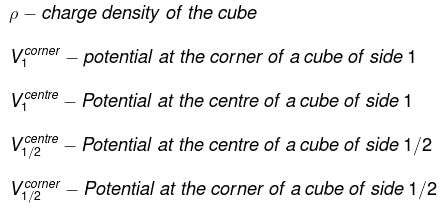
By dimensional analysis


but by superposition

Because of the centre of the larger cube lies at a corner of the eight smaller cubes of which it is made
therefore,


Because of the centre of the larger cube lies at a corner of the eight smaller cubes of which it is made
therefore,

when two capacitors are put in series, the equivalent capacitance is - a)the reciprocal of the capacitances
- b)smaller than both capacitances
- c)the sum of the capacitances
- d)the product of the capacitances
Correct answer is option 'B'. Can you explain this answer?
when two capacitors are put in series, the equivalent capacitance is
a)
the reciprocal of the capacitances
b)
smaller than both capacitances
c)
the sum of the capacitances
d)
the product of the capacitances

|
Tarun Chakraborty answered |
Explanation:When two capacitors C1 and C2 are connected in series, the reciprocal of the equivalent capacitance in series is equal to the sum of the reciprocals of the two individual capacitances.
It has value lesser than the least value of capacitance.
Two metallic spheres of radii 1 cm and 3 cm are given charges of (-1 x 10-2 C) and 5 x 10-2 C , respectively. If these are connected by a conducting wire, the final charge on the bigger sphere is:
- a)2 x 10-2 C
- b)3 x 10-2 C
- c)4 x 10-2 C
- d)1 x 10-2 C
Correct answer is option 'B'. Can you explain this answer?
Two metallic spheres of radii 1 cm and 3 cm are given charges of (-1 x 10-2 C) and 5 x 10-2 C , respectively. If these are connected by a conducting wire, the final charge on the bigger sphere is:
a)
2 x 10-2 C
b)
3 x 10-2 C
c)
4 x 10-2 C
d)
1 x 10-2 C
|
|
Rajeev Saxena answered |
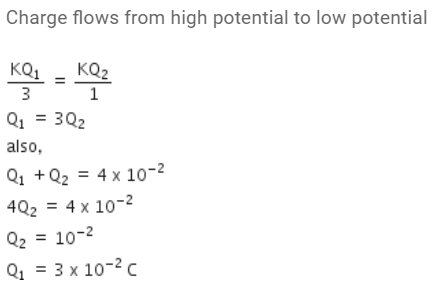
What is the direction of the lines of force at any point on the equipotential surface?- a)Parallel to it
- b)Perpendicular to it.
- c)Inclined at 45 degrees
- d)None of the above
Correct answer is option 'B'. Can you explain this answer?
What is the direction of the lines of force at any point on the equipotential surface?
a)
Parallel to it
b)
Perpendicular to it.
c)
Inclined at 45 degrees
d)
None of the above
|
|
Anjali Iyer answered |
When electric lines of force get perpendicular to equipotential surface then area vector and electric lines of force are parallel to each other.so angle between them is zero. due to that reason they get perpendicular to each other.
Equipotential surfaces cannot- a)be parallel
- b)be spherical
- c)Intersect
- d)be irregularly shaped.
Correct answer is option 'C'. Can you explain this answer?
Equipotential surfaces cannot
a)
be parallel
b)
be spherical
c)
Intersect
d)
be irregularly shaped.
|
|
Krishna Iyer answered |
The electric field lines are perpendicular to the equipotential surface. The field lines can not intersect each other because the electric force can not have two directions at a point.
If the potential difference between the plates of a capacitor is increased by 0.1%, the energy stored in the capacitor increases by very nearly- a)0.1%
- b)0.144%
- c)0.11%
- d)0.2%
Correct answer is option 'D'. Can you explain this answer?
If the potential difference between the plates of a capacitor is increased by 0.1%, the energy stored in the capacitor increases by very nearly
a)
0.1%
b)
0.144%
c)
0.11%
d)
0.2%
|
|
Amar Shah answered |
**Explanation:**
To understand why the correct answer is option 'D', let's consider the equation for the energy stored in a capacitor:
**Energy (E) = 1/2 * C * V^2**
where E is the energy, C is the capacitance, and V is the potential difference (voltage) across the capacitor plates.
According to the question, the potential difference between the plates of the capacitor is increased by 0.1%. Let the initial potential difference be V1 and the increased potential difference be V2.
**Change in Potential Difference = (V2 - V1) = 0.1% of V1**
Using this information, we can write the new potential difference as:
**V2 = V1 + (0.1/100) * V1 = V1 + 0.001 * V1 = (1 + 0.001) * V1 = 1.001 * V1**
Next, we need to find the change in energy stored in the capacitor. Let the initial energy be E1 and the increased energy be E2.
**Change in Energy = (E2 - E1) = ?**
Using the equation for energy, we can write the new energy as:
**E2 = 1/2 * C * V2^2 = 1/2 * C * (1.001 * V1)^2 = 1/2 * C * (1.001^2) * V1^2**
Now, let's calculate the change in energy:
**Change in Energy = (E2 - E1) = 1/2 * C * (1.001^2) * V1^2 - 1/2 * C * V1^2**
Simplifying this expression:
**Change in Energy = 1/2 * C * V1^2 * (1.001^2 - 1) = 1/2 * C * V1^2 * (1.001^2 - 1)**
To find the percentage increase in energy, we need to divide the change in energy by the initial energy and multiply by 100. Let's calculate:
**Percentage Increase in Energy = (Change in Energy / E1) * 100**
Substituting the expression for change in energy:
**Percentage Increase in Energy = [1/2 * C * V1^2 * (1.001^2 - 1)] / [1/2 * C * V1^2] * 100**
Simplifying this expression:
**Percentage Increase in Energy = (1.001^2 - 1) * 100 = (1.001 * 1.001 - 1) * 100 = (1.002001 - 1) * 100 = 0.2001 * 100 = 0.2%**
Therefore, the energy stored in the capacitor increases by approximately 0.2% when the potential difference between the plates is increased by 0.1%. Hence, the correct answer is option 'D' (0.2%).
To understand why the correct answer is option 'D', let's consider the equation for the energy stored in a capacitor:
**Energy (E) = 1/2 * C * V^2**
where E is the energy, C is the capacitance, and V is the potential difference (voltage) across the capacitor plates.
According to the question, the potential difference between the plates of the capacitor is increased by 0.1%. Let the initial potential difference be V1 and the increased potential difference be V2.
**Change in Potential Difference = (V2 - V1) = 0.1% of V1**
Using this information, we can write the new potential difference as:
**V2 = V1 + (0.1/100) * V1 = V1 + 0.001 * V1 = (1 + 0.001) * V1 = 1.001 * V1**
Next, we need to find the change in energy stored in the capacitor. Let the initial energy be E1 and the increased energy be E2.
**Change in Energy = (E2 - E1) = ?**
Using the equation for energy, we can write the new energy as:
**E2 = 1/2 * C * V2^2 = 1/2 * C * (1.001 * V1)^2 = 1/2 * C * (1.001^2) * V1^2**
Now, let's calculate the change in energy:
**Change in Energy = (E2 - E1) = 1/2 * C * (1.001^2) * V1^2 - 1/2 * C * V1^2**
Simplifying this expression:
**Change in Energy = 1/2 * C * V1^2 * (1.001^2 - 1) = 1/2 * C * V1^2 * (1.001^2 - 1)**
To find the percentage increase in energy, we need to divide the change in energy by the initial energy and multiply by 100. Let's calculate:
**Percentage Increase in Energy = (Change in Energy / E1) * 100**
Substituting the expression for change in energy:
**Percentage Increase in Energy = [1/2 * C * V1^2 * (1.001^2 - 1)] / [1/2 * C * V1^2] * 100**
Simplifying this expression:
**Percentage Increase in Energy = (1.001^2 - 1) * 100 = (1.001 * 1.001 - 1) * 100 = (1.002001 - 1) * 100 = 0.2001 * 100 = 0.2%**
Therefore, the energy stored in the capacitor increases by approximately 0.2% when the potential difference between the plates is increased by 0.1%. Hence, the correct answer is option 'D' (0.2%).
A hollow metal sphere of radius 20 cm is charged such that the potential on its surface is 120 Volt. The potential at the centre of the sphere is- a)80 V
- b)6 V
- c)120 V
- d)Zero
Correct answer is 'C'. Can you explain this answer?
A hollow metal sphere of radius 20 cm is charged such that the potential on its surface is 120 Volt. The potential at the centre of the sphere is
a)
80 V
b)
6 V
c)
120 V
d)
Zero
|
|
Anjana Sharma answered |
Potential inside the charged sphere is constant and equal to potential on the surface. Hence the potential at the centre of the sphere is 120 V.
The amount of work done in moving a unit positive charge through distance of 10 cm on an equipotential surface is- a)100 joule
- b)10 cm
- c)1/10 cm
- d)Zero
Correct answer is option 'D'. Can you explain this answer?
The amount of work done in moving a unit positive charge through distance of 10 cm on an equipotential surface is
a)
100 joule
b)
10 cm
c)
1/10 cm
d)
Zero

|
Anupam Singh answered |
Zero because at equipotential surface potential difference is zero
Electric potential due to a point charge q at a distance r from the point is _______ (in the air).- a)q/r
- b)q*r
- c)q/r2
- d)-q/r
Correct answer is option 'A'. Can you explain this answer?
Electric potential due to a point charge q at a distance r from the point is _______ (in the air).
a)
q/r
b)
q*r
c)
q/r2
d)
-q/r
|
|
Om Desai answered |
Force on a unit point charge kept at a distance r from the charge = q/r2.
Therefore, work done to bring that point charge through a small distance dr = q/r2 * (-dr). Therefore, the potential of that point is =  .
.
 .
.A metal sphere carries a charge of 5×10-8C and is at a potential of 200 V, relative to the potential far away. The potential at the centre of the sphere is:- a)-100V
- b)0
- c)200V
- d)2×10-6v
Correct answer is option 'C'. Can you explain this answer?
A metal sphere carries a charge of 5×10-8C and is at a potential of 200 V, relative to the potential far away. The potential at the centre of the sphere is:
a)
-100V
b)
0
c)
200V
d)
2×10-6v
|
|
Keerthana Iyer answered |
Given data:
Charge on the sphere, q = 5.1 × 10⁻⁸ C
Potential difference, V = 200 V
We know that the formula for potential difference is:
V = kq/r
where k is Coulomb's constant, q is the charge on the sphere and r is the radius of the sphere.
Calculating the radius of the sphere:
r = kq/V
r = (9 × 10^9 Nm^2/C^2 × 5.1 × 10⁻⁸ C) / (200 V)
r = 2.295 × 10⁻⁴ m
The potential at the centre of the sphere is given by:
V' = kq/R
where R is the radius of the sphere.
As the point is at the centre of the sphere, R = r.
V' = kq/r
V' = (9 × 10^9 Nm^2/C^2 × 5.1 × 10⁻⁸ C) / (2.295 × 10⁻⁴ m)
V' = 2 × 10² V
Therefore, the potential at the centre of the sphere is 200 V (option C).
Charge on the sphere, q = 5.1 × 10⁻⁸ C
Potential difference, V = 200 V
We know that the formula for potential difference is:
V = kq/r
where k is Coulomb's constant, q is the charge on the sphere and r is the radius of the sphere.
Calculating the radius of the sphere:
r = kq/V
r = (9 × 10^9 Nm^2/C^2 × 5.1 × 10⁻⁸ C) / (200 V)
r = 2.295 × 10⁻⁴ m
The potential at the centre of the sphere is given by:
V' = kq/R
where R is the radius of the sphere.
As the point is at the centre of the sphere, R = r.
V' = kq/r
V' = (9 × 10^9 Nm^2/C^2 × 5.1 × 10⁻⁸ C) / (2.295 × 10⁻⁴ m)
V' = 2 × 10² V
Therefore, the potential at the centre of the sphere is 200 V (option C).
The value of electric field vector  along the surface of constant potential of 100 V
along the surface of constant potential of 100 V- a)100 V/m
- b)-100 V/m
- c)10 V/m
- d)Zero
Correct answer is option 'D'. Can you explain this answer?
The value of electric field vector  along the surface of constant potential of 100 V
along the surface of constant potential of 100 V
a)
100 V/m
b)
-100 V/m
c)
10 V/m
d)
Zero
|
|
Anjana Sharma answered |
As we know that electric field is in reverse sense of the directional gradient of electric potential, so if V is constant, E should be zero. So, for E to be zero, either V has to be zero, or constant, or the 3 directional derivative components of V must cancel out each other in space. So we cant claim that V always has to be zero, if E is zero in a region, since E is a vector & V is a scalar quantity. But if V is zero, then surely E has to be zero; the reverse case is not true always.
hope it was helpful...
64 water drops having equal charges combine to form one bigger drop. The capacitance of the bigger drop, as compared to that of smaller drop will be- a)64 times
- b)8 times
- c)16 times
- d)4 times
Correct answer is option 'D'. Can you explain this answer?
64 water drops having equal charges combine to form one bigger drop. The capacitance of the bigger drop, as compared to that of smaller drop will be
a)
64 times
b)
8 times
c)
16 times
d)
4 times
|
|
Hansa Sharma answered |
Capacitance of the small drop of radius r C8 = 4πε0r and that of the big drop of radius R is CB = 4πε0R .
The volume of 64 small drops,
The ratio
The volume of 64 small drops,

The ratio

Shape of equipotential surfaces for a uniform electric field along x-axis are- a)Planes along x-z direction
- b)Planes along x-y direction
- c)Planes normal to field
- d)Concentric spherical shells
Correct answer is option 'C'. Can you explain this answer?
Shape of equipotential surfaces for a uniform electric field along x-axis are
a)
Planes along x-z direction
b)
Planes along x-y direction
c)
Planes normal to field
d)
Concentric spherical shells
|
|
Swati Verma answered |
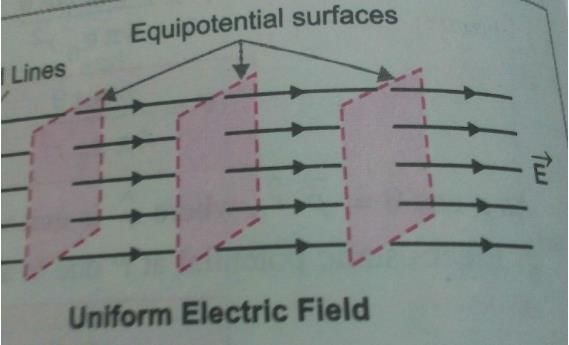
Shape of equipotential surfaces for a uniform electric field along x-axis are Planes normal to the field.
Optical analogue of an equipotential surface is- a)Wavefront of light
- b)Wave motion of light
- c)Reflection of light
- d)Interference of light
Correct answer is option 'A'. Can you explain this answer?
Optical analogue of an equipotential surface is
a)
Wavefront of light
b)
Wave motion of light
c)
Reflection of light
d)
Interference of light
|
|
Rohit Shah answered |
Optical analogue of anequipotential surface is. Wavefronts are surfaces of constant phase. Similarly,equipotential surface due to point charge is spherical in shape and has same potential at each point on selected surface.
If a charge moves in an electrical field - a)energy is lost
- b)energy is gained
- c)energy is conserved
- d)energy is unchanged
Correct answer is option 'C'. Can you explain this answer?
If a charge moves in an electrical field
a)
energy is lost
b)
energy is gained
c)
energy is conserved
d)
energy is unchanged

|
Maitri Mukherjee answered |
When a charged particle moves in an electric field, if its electric potential energy decreases, its kinetic energy will increase. In other words, the total energy is conserved.
In electrolytic capacitors positive terminal is- a)one on which aluminium oxide film is formed
- b)none of the above.
- c)either of the two terminals
- d)one on which aluminium oxide film is not formed
Correct answer is option 'A'. Can you explain this answer?
In electrolytic capacitors positive terminal is
a)
one on which aluminium oxide film is formed
b)
none of the above.
c)
either of the two terminals
d)
one on which aluminium oxide film is not formed

|
Juhi Deshpande answered |
Explanation:Aluminium electrolytic capacitors have the Aluminium foil anode (positive terminal) which is etched and covered with a layer of Aluminium Oxide which acts as a dielectric. The whole assembly is covered using a paper separator soaked in electrolyte such as, Borax or Glycol and covered by Aluminium foil which acts as cathode ( negative electrode)
Electric field intensity and electric potential at a certain distance from a point charge is 32 N/C and 16 J/C. What is the distance from the charge?- a)50 m
- b)0.5 m
- c)10 m
- d)7 m
Correct answer is option 'B'. Can you explain this answer?
Electric field intensity and electric potential at a certain distance from a point charge is 32 N/C and 16 J/C. What is the distance from the charge?
a)
50 m
b)
0.5 m
c)
10 m
d)
7 m
|
|
Nikita Singh answered |
Electric field due to a charge q at a distance r is  and electric potential at that point is
and electric potential at that point is  Therefore,
Therefore,  and
and  Dividing these two equations, we get r=0.5m. If the medium is air, k=1. Thus we can get the value of q=0.89 C.
Dividing these two equations, we get r=0.5m. If the medium is air, k=1. Thus we can get the value of q=0.89 C.
 and electric potential at that point is
and electric potential at that point is  Therefore,
Therefore,  and
and  Dividing these two equations, we get r=0.5m. If the medium is air, k=1. Thus we can get the value of q=0.89 C.
Dividing these two equations, we get r=0.5m. If the medium is air, k=1. Thus we can get the value of q=0.89 C.Calculate electric potential due to a point charge of 10C at a distance of 8cm away from the charge.
- a)1.125*1013V
- b)1.125*1012V
- c)2.25*1013V
- d)0.62*1013V
Correct answer is option 'B'. Can you explain this answer?
Calculate electric potential due to a point charge of 10C at a distance of 8cm away from the charge.
a)
1.125*1013V
b)
1.125*1012V
c)
2.25*1013V
d)
0.62*1013V
|
|
Nikita Singh answered |
In the SI system, electric potential due to a point charge at a distance r is  .
.
Substituting the values, we get potential =
V = 1.125*1012V. Though in practice, this huge value of electric potential is not present.
 .
.Substituting the values, we get potential =

V = 1.125*1012V. Though in practice, this huge value of electric potential is not present.
It requires 4 J of work to move a charge of 20 C from point A to point B, separated by a distance of 0.2 cm. The potential difference between A and B in volts- a)0.2
- b)16
- c)5
- d)80
Correct answer is 'A'. Can you explain this answer?
It requires 4 J of work to move a charge of 20 C from point A to point B, separated by a distance of 0.2 cm. The potential difference between A and B in volts
a)
0.2
b)
16
c)
5
d)
80

|
Ishani Yadav answered |
Potential difference between two points is given by
Va - Vb = W/q0
Work, W = 2 J
Charge, q0 = 20 C
Potential difference = 2/20 = 0.1 V
The correct option is C.
Equal charges are given to two spheres of different radii. The potential will- a)be equal on both the spheres
- b)be more on the smaller sphere
- c)be more on the bigger sphere
- d)depend on the material of the sphere
Correct answer is option 'B'. Can you explain this answer?
Equal charges are given to two spheres of different radii. The potential will
a)
be equal on both the spheres
b)
be more on the smaller sphere
c)
be more on the bigger sphere
d)
depend on the material of the sphere
|
|
Rajesh Gupta answered |
When equal charges are given to two spheres of different radii, the potential will be more or the smaller sphere as per the equation, Potential = Charge / Radius.
Since potential is inversely proportional to radius, the smaller radius will have higher potential and vice versa.
Since potential is inversely proportional to radius, the smaller radius will have higher potential and vice versa.
The capacitance of a parallel plate capacitor is 5 μF . When a glass slab of thickness equal to the separation between the plates is introduced between the plates, the potential difference reduces to 1/8 of the original value. The dielectric constant of glass is- a)40
- b)8
- c)5
- d)1.6
Correct answer is option 'B'. Can you explain this answer?
The capacitance of a parallel plate capacitor is 5 μF . When a glass slab of thickness equal to the separation between the plates is introduced between the plates, the potential difference reduces to 1/8 of the original value. The dielectric constant of glass is
a)
40
b)
8
c)
5
d)
1.6
|
|
Anu Sharma answered |
Solution:
Given, capacitance of parallel plate capacitor, C = 5 F
Let d be the separation between the plates of the capacitor.
When a glass slab of thickness d is introduced between the plates, the potential difference reduces to 1/8 of the original value.
Let V be the original potential difference between the plates.
Let K be the dielectric constant of the glass slab.
The capacitance of the capacitor with a dielectric medium between the plates is given by:
C' = KC
The potential difference between the plates of the capacitor with the dielectric medium between them is given by:
V' = V/8
Calculation:
The capacitance of the capacitor with the dielectric medium between the plates is given by:
C' = KC
5K = C'
The potential difference between the plates of the capacitor with the dielectric medium between them is given by:
V' = V/8
V/8 = V - q/C'
where q is the charge on the plates.
q = CV = 8V'/C'
Substituting q in the above equation, we get:
V/8 = V - 8V'/C'
8V' = V/8 x C'
8V' = V/8 x 5K
K = 8 x 8/5
K = 64/5 ≈ 12.8
Therefore, the dielectric constant of the glass slab is 8.
Given, capacitance of parallel plate capacitor, C = 5 F
Let d be the separation between the plates of the capacitor.
When a glass slab of thickness d is introduced between the plates, the potential difference reduces to 1/8 of the original value.
Let V be the original potential difference between the plates.
Let K be the dielectric constant of the glass slab.
The capacitance of the capacitor with a dielectric medium between the plates is given by:
C' = KC
The potential difference between the plates of the capacitor with the dielectric medium between them is given by:
V' = V/8
Calculation:
The capacitance of the capacitor with the dielectric medium between the plates is given by:
C' = KC
5K = C'
The potential difference between the plates of the capacitor with the dielectric medium between them is given by:
V' = V/8
V/8 = V - q/C'
where q is the charge on the plates.
q = CV = 8V'/C'
Substituting q in the above equation, we get:
V/8 = V - 8V'/C'
8V' = V/8 x C'
8V' = V/8 x 5K
K = 8 x 8/5
K = 64/5 ≈ 12.8
Therefore, the dielectric constant of the glass slab is 8.
When 2 charged conductors are connected by a wire,- a)there is loss or gain of energy depending upon the potentials of the
- b)there is always loss of energy
- c)there will not be any change in energy
- d)there is always gain of energy
Correct answer is option 'B'. Can you explain this answer?
When 2 charged conductors are connected by a wire,
a)
there is loss or gain of energy depending upon the potentials of the
b)
there is always loss of energy
c)
there will not be any change in energy
d)
there is always gain of energy
|
|
Priya Chavan answered |
Let the two conductors have capacitances C1 and C2 and let their potentials be V1 and V2 . Total initial energy of the conductors Ui=1/2C1V12+1/2C2V22. When two charged conductors are connected by a wire, the flow of charge stops when the potentials are equalized. Let V be the common potential and Q1 and Q2 be the charges on the conductors after the common potential is attained.


The final energy
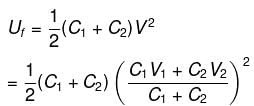


Electric Potential V at a point in an electrical field is - a)potential energy of an electron placed at that point.
- b)potential energy of a proton placed at that point.
- c)potential energy of all charges in the field.
- d)potential energy of a unit charge placed at that point.
Correct answer is option 'D'. Can you explain this answer?
Electric Potential V at a point in an electrical field is
a)
potential energy of an electron placed at that point.
b)
potential energy of a proton placed at that point.
c)
potential energy of all charges in the field.
d)
potential energy of a unit charge placed at that point.

|
Pooja Pillai answered |
Explanation:
Electric Potential V at a point in an electrical field:
- The electric potential V at a point in an electrical field is defined as the potential energy per unit charge at that point. It is denoted by V and is measured in volts (V).
- The electric potential at a point in an electric field is the work done in bringing a unit positive charge from infinity to that point.
- The electric potential V at a point in an electric field is given by the formula V = W/q, where W is the work done in bringing the charge q from infinity to that point.
Potential energy of a unit charge placed at that point:
- The electric potential V at a point in an electric field is the potential energy of a unit positive charge placed at that point.
- This means that the electric potential V at a point in an electric field represents the potential energy of a unit positive charge at that point.
Conclusion:
Therefore, the correct option is 'D' - potential energy of a unit charge placed at that point. The electric potential V at a point in an electrical field represents the potential energy of a unit positive charge placed at that point.
Electric Potential V at a point in an electrical field:
- The electric potential V at a point in an electrical field is defined as the potential energy per unit charge at that point. It is denoted by V and is measured in volts (V).
- The electric potential at a point in an electric field is the work done in bringing a unit positive charge from infinity to that point.
- The electric potential V at a point in an electric field is given by the formula V = W/q, where W is the work done in bringing the charge q from infinity to that point.
Potential energy of a unit charge placed at that point:
- The electric potential V at a point in an electric field is the potential energy of a unit positive charge placed at that point.
- This means that the electric potential V at a point in an electric field represents the potential energy of a unit positive charge at that point.
Conclusion:
Therefore, the correct option is 'D' - potential energy of a unit charge placed at that point. The electric potential V at a point in an electrical field represents the potential energy of a unit positive charge placed at that point.
If the diameter of earth is 128×102km, then its capacitance will be- a)111 μF
- b)331 μF
- c)711 μF
- d)211 μF
Correct answer is option 'C'. Can you explain this answer?
If the diameter of earth is 128×102km, then its capacitance will be
a)
111 μF
b)
331 μF
c)
711 μF
d)
211 μF

|
Arshiya Choudhury answered |
the capacitance of a spherical conductor of radius R is

If the diameter of earth is 128 x 102 km, then its capacitance will be- a)111 μF
- b)331 μF
- c)711 μF
- d)211 μF
Correct answer is option 'C'. Can you explain this answer?
If the diameter of earth is 128 x 102 km, then its capacitance will be
a)
111 μF
b)
331 μF
c)
711 μF
d)
211 μF
|
|
Ashwini Shah answered |
The capacitance of a spherical conductor of radius R is


An electrolytic capacitor is marked 8 μF, 220 V. It can be used in a circuit where the p.d. across the capacitor may be- a)300 V
- b)500 V
- c)200 V
- d)1000 V
Correct answer is option 'D'. Can you explain this answer?
An electrolytic capacitor is marked 8 μF, 220 V. It can be used in a circuit where the p.d. across the capacitor may be
a)
300 V
b)
500 V
c)
200 V
d)
1000 V

|
Pritam Malik answered |
Explanation:The break down potential of the capacitor is 220 V. In order to prevent damage to a capacitor, it should be always used in a circuit where the p.d is less than its break down potential. The p.d difference can only be 200 V.
Submarine cables act as- a)cylindrical capacitor with outer cylinder earthed
- b)parallel plate capacitor
- c)cylindrical capacitor with inner cylinder earthed.
- d)spherical capacitor
Correct answer is option 'A'. Can you explain this answer?
Submarine cables act as
a)
cylindrical capacitor with outer cylinder earthed
b)
parallel plate capacitor
c)
cylindrical capacitor with inner cylinder earthed.
d)
spherical capacitor

|
Harsh Mehta answered |
Explanation:A submarine cable consists of an inner conductor which carries power. This conductor is covered by an insulator, which acts as a dielectric. The dielectric material is covered by a metal coating called shield, which is connected to ground.
The cable acts as a cylindrical capacitor, with the conductor acting as the inner cylinder, and the metal shield as the outer cylinder which is connected to earth.
For a charged conductor of arbitrary shape, inside the conductor- a)V= 0 and E≠0
- b)E=0, but V is same as on the surface and non-zero
- c)E is non-uniform but V is zero everywhere
- d)E and V are zero
Correct answer is option 'B'. Can you explain this answer?
For a charged conductor of arbitrary shape, inside the conductor
a)
V= 0 and E≠0
b)
E=0, but V is same as on the surface and non-zero
c)
E is non-uniform but V is zero everywhere
d)
E and V are zero
|
|
Gowri Sen answered |
The electric field on the surface of a hollow conductor is maximum and it drops to zero abruptly inside the conductor. Since
E = - dV\dr
E = - dV\dr
the potential difference between any two points inside the hollow conductor is zero. This means that the potential at all points inside the hollow charged conductor is same and it is equal to the value of the potential at its surface
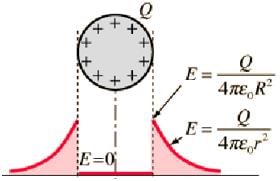
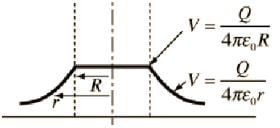
A capacitor of capacitance C is fully charged by a 200 V supply. It is then discharged through a small coil of resistance wire embedded in a thermally insulated block of specific heat 2.5×102Jkg−1K−1 and of mass 0.1 kg. If the temperature of the block rises by 0.4 K, what is the value of C?- a)300 μF
- b)500 μF
- c)400 μF
- d)200 μF
Correct answer is option 'B'. Can you explain this answer?
A capacitor of capacitance C is fully charged by a 200 V supply. It is then discharged through a small coil of resistance wire embedded in a thermally insulated block of specific heat 2.5×102Jkg−1K−1 and of mass 0.1 kg. If the temperature of the block rises by 0.4 K, what is the value of C?
a)
300 μF
b)
500 μF
c)
400 μF
d)
200 μF

|
Pankaj Sengupta answered |
Given data:
- Voltage supply (V) = 200 V
- Specific heat of block (c) = 2.5×10² Jkg⁻¹K⁻¹
- Mass of block (m) = 0.1 kg
- Temperature rise (ΔT) = 0.4 K
Calculation:
- The energy stored in the capacitor when fully charged is given by:
\[ E = \frac{1}{2}CV^2 \]
- The energy dissipated in the resistor when the capacitor is discharged is equal to the heat gained by the block:
\[ Q = mcΔT \]
- Equating the two equations:
\[ \frac{1}{2}CV^2 = mcΔT \]
- Substituting the given values and solving for C:
\[ C = \frac{2mcΔT}{V^2} \]
\[ C = \frac{2 * 0.1 * 2.5×10² * 0.4}{200^2} \]
\[ C = \frac{2 * 0.1 * 250 * 0.4}{40000} \]
\[ C = \frac{20}{40000} \]
\[ C = 500μF \]
Therefore, the value of capacitance C is 500μF. Hence, option 'B' is correct.
- Voltage supply (V) = 200 V
- Specific heat of block (c) = 2.5×10² Jkg⁻¹K⁻¹
- Mass of block (m) = 0.1 kg
- Temperature rise (ΔT) = 0.4 K
Calculation:
- The energy stored in the capacitor when fully charged is given by:
\[ E = \frac{1}{2}CV^2 \]
- The energy dissipated in the resistor when the capacitor is discharged is equal to the heat gained by the block:
\[ Q = mcΔT \]
- Equating the two equations:
\[ \frac{1}{2}CV^2 = mcΔT \]
- Substituting the given values and solving for C:
\[ C = \frac{2mcΔT}{V^2} \]
\[ C = \frac{2 * 0.1 * 2.5×10² * 0.4}{200^2} \]
\[ C = \frac{2 * 0.1 * 250 * 0.4}{40000} \]
\[ C = \frac{20}{40000} \]
\[ C = 500μF \]
Therefore, the value of capacitance C is 500μF. Hence, option 'B' is correct.
Three positive charges are kept at the vertices of an equilateral triangle. We can make the potential energy of the system zero by adjusting the amount of charges. This statement is ______- a)True
- b)False
Correct answer is option 'B'. Can you explain this answer?
Three positive charges are kept at the vertices of an equilateral triangle. We can make the potential energy of the system zero by adjusting the amount of charges. This statement is ______
a)
True
b)
False
|
|
Shalini Patel answered |
Electric potential is a positive quantity if both the charges are positive. In this case, all the three charges are positive; hence there is no negative term in the total energy term. Therefore, we cannot make the total energy of the system zero by adjusting the values of charge. But it would be possible if one of the charges were positive.
Chapter doubts & questions for Electrostatic Potential - Physics for EmSAT Achieve 2025 is part of EmSAT Achieve exam preparation. The chapters have been prepared according to the EmSAT Achieve exam syllabus. The Chapter doubts & questions, notes, tests & MCQs are made for EmSAT Achieve 2025 Exam. Find important definitions, questions, notes, meanings, examples, exercises, MCQs and online tests here.
Chapter doubts & questions of Electrostatic Potential - Physics for EmSAT Achieve in English & Hindi are available as part of EmSAT Achieve exam.
Download more important topics, notes, lectures and mock test series for EmSAT Achieve Exam by signing up for free.
Physics for EmSAT Achieve
208 videos|329 docs|212 tests
|

